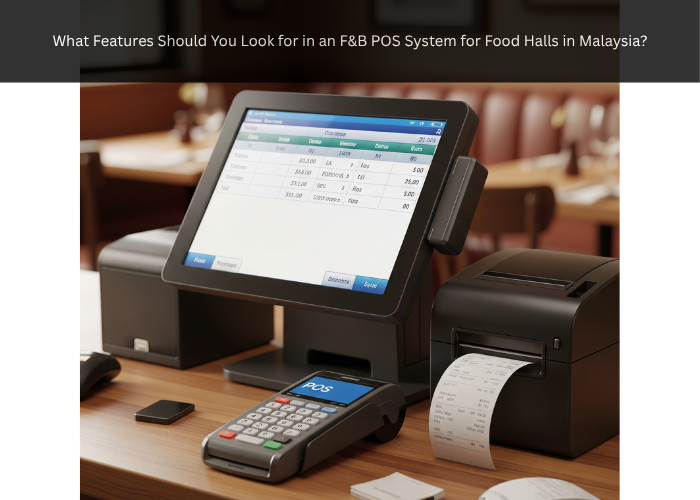A Good F&B POS System for Food Halls Must Support Multi-Vendor Operations
One of the biggest challenges in food hall management is coordinating multiple food vendors under one roof. A robust F&B POS System should allow centralized management while giving individual vendors access to their own sales, inventory, and reporting dashboards.
Key functions to look for:
Separate accounts and logins per stall
Central management for admins or food hall operators
Order routing by vendor
Payment splitting across multiple stalls
Real-time monitoring of each vendor’s sales and performance
In a Malaysian food hall where you might have 10 or more stalls, it’s critical that your F&B POS System prevents operational chaos by giving both control and flexibility.
An F&B POS System for Food Halls in Malaysia Must Offer Local Payment Integration
Malaysia’s diners love flexibility—e-wallets, QR codes, debit cards, and cashless methods are standard. Your F&B POS System should support:
DuitNow QR
Touch ‘n Go eWallet
GrabPay
ShopeePay
Maybank QRPay
Debit and credit card readers
Mobile payment terminals
The more payment options your system can handle, the better the customer experience. Payment should be smooth even in stalls with limited space or staff. A strong F&B POS System reduces long queues, manual inputs, and human error.
Choose an F&B POS System with Shared Inventory and Ingredient-Level Tracking
Inventory control is not just for restaurants—it’s vital in food halls too. A centralized F&B POS System should allow operators to:
Track ingredient usage per dish
Alert stalls about low or expiring stock
Share ingredient pools across vendors (e.g., common drink ingredients or sauces)
Reduce food wastage
Forecast demand for better purchasing
In Malaysia’s fast-paced food hall settings, this feature minimizes delays and helps vendors stay consistent even when managing multiple menus.
The Best F&B POS System for Food Halls Must Include Kitchen Display System (KDS) Integration
Speed and accuracy are crucial in food halls where high footfall is normal. A well-designed F&B POS System should support KDS, allowing orders to be sent directly to the right stall’s kitchen display or printer.
This avoids shouting orders, missed tickets, or confused staff. Features to look for include:
Order queue tracking
Timer for prep and delivery
Stall-specific routing
Kitchen updates to front counter (e.g., “ready,” “delayed”)
Notifications to customers via SMS or number screens
A KDS cuts down noise and improves professionalism. In food halls like those in Kuala Lumpur or Johor Bahru, this ensures fast turnover and better order accuracy.
Real-Time Sales and Performance Reports Are Essential in an F&B POS System
If you can’t see what’s selling and when, you’re managing in the dark. The best F&B POS System should offer analytics on:
Hourly and daily sales by stall
High-performing menu items
Stall comparison reports
Customer payment preferences
Inventory movement
Peak ordering times
Staff performance per shift or outlet
With real-time data, food hall managers can make strategic decisions—such as adjusting pricing, marketing low-performing vendors, or rotating stalls based on foot traffic.
Look for Scalability in Any F&B POS System for Food Halls in Malaysia
As your food hall grows—from 5 stalls to 15—you need a F&B POS System that scales with you. Look for features like:
Cloud-based platform with unlimited stall support
Central dashboard access for owners
Easy onboarding for new vendors
Customizable pricing per vendor or item
Multi-language interface for staff
Also, future-ready POS systems allow integration with marketing tools, CRM platforms, and delivery aggregators like GrabFood or foodpanda, which many Malaysian food halls rely on to boost sales.
A Great F&B POS System Should Support Loyalty Programs Across All Vendors
Most customers return not just for one vendor—but for the variety your food hall offers. A unified loyalty program helps you retain them across multiple stalls.
Top features include:
Points accumulation across vendors
Redeemable discounts or free items
QR code-based customer ID
Birthday vouchers
Mobile app integration
E-gift card compatibility
A solid F&B POS System builds customer loyalty while giving vendors valuable insights into customer preferences.
Conclusion: The Right F&B POS System Drives Operational Success for Malaysian Food Halls
Food halls are booming in Malaysia, especially in urban centers like Penang, Kuala Lumpur, and Johor Bahru. But managing them is no small feat. You need a powerful, reliable, and tailored F&B POS System that’s designed for complexity.
Look for a solution that includes:
Multi-vendor support
Local payment flexibility
Real-time kitchen displays
Centralized inventory
Detailed analytics
Loyalty integration
Multi-branch scalability
Choosing the wrong POS can lead to vendor frustration, longer queues, inventory chaos, and lost revenue. With the right F&B POS System in place, your food hall will be ready for growth, better customer service, and long-term profitability in 2025 and beyond.








